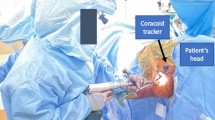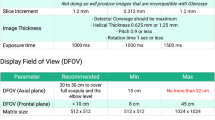Abstract
Purpose
Total and reverse total shoulder arthroplasty (TSA) are used to treat patients with glenohumeral joint osteoarthritis. The revision rate remains high compared with hip and knee arthroplasty. Glenoid component loosening is an important complication and may be caused by poor positioning of the component. We aimed to evaluate the safety and accuracy of a custom glenoid jig created using preoperative computed tomography (CT) imaging with 3D modelling for glenoid component implantation.
Methods
Preoperative CT scans of each shoulder (N = 7) were obtained. Implants were virtually aligned and custom templates were created for intraoperative use. A two-part custom jig was manufactured for alignment of the central peg and the peripheral screws. Three-dimensional orientation of the component and screws was evaluated in postoperative CT scans. The difference between the preoperative plan and the result was then calculated.
Results
No technical difficulties or complications occurred. The mean absolute difference between the planned alignment and the postoperative placement of the glenoid component in the three-dimensional space was 3.4 mm (SD = 1 mm). The total average difference for all screws (N = 10) was 6.3° (SD = 3.2°).
Conclusion
A CT-based custom glenoid component alignment can reliably guide the placement of the glenoid component during conventional and reverse TSA. This custom jig may be useful for optimizing glenoid component position in the setting of reverse and TSA.
Level of evidence
IV.





Similar content being viewed by others
References
Adams JE, Sperling JW, Schleck CD, Harmsen WS, Cofield RH (2007) Outcomes of shoulder arthroplasty in Olmsted County, Minnesota: a population-based study. Clin Orthop Relat Res 455:176–182
Boileau P, Gonzalez JF, Chuinard C, Bicknell R, Walch G (2009) Reverse total shoulder arthroplasty after failed rotator cuff surgery. J Shoulder Elbow Surg 18(4):600–606
Brems J (1993) The glenoid component in total shoulder arthroplasty. J Shoulder Elbow Surg 2:47–54
Churchill RS, Brems JJ, Kotschi H (2001) Glenoid size, inclination, and version: an anatomic study. J Shoulder Elbow Surg 10(4):327–332
Cil A, Veillette CJH, Sanchez-Sotelo J, Sperling JW, Schleck CD, Cofield RH (2010) Survivorship of the humeral component in shoulder arthroplasty. J Shoulder Elbow Surg 19(1):143–150
Cofield RH (2007) Bone grafting for glenoid bone deficiencies in shoulder arthritis: a review. J Shoulder Elbow Surg 16(5 Suppl):S273–S281
Couteau B, Mansat P, Mansat M, Darmana R, Egan J (2001) In vivo characterization of glenoid with use of computed tomography. J Shoulder Elbow Surg 10(2):116–122
Cyprien J, Vasey H, Burdet A, Bonvin J, Kritsikis N, Vuagnat P (1983) Humeral retrotorsion and glenohumeral relationship in the normal shoulder and in recurrent anterior dislocation (scapulometry). Clin Orthop Relat Res 175:8–17
Edwards TB, Boulahia A, Kempf JF, Boileau P, Nemoz C, Walch G (2002) The influence of rotator cuff disease on the results of shoulder arthroplasty for primary osteoarthritis: results of a multicenter study. J Bone Joint Surg Am 84-A(12):2240–2248
Edwards TB, Gartsman GM, O’Connor DP, Sarin VK (2008) Safety and utility of computer-aided shoulder arthroplasty. J Shoulder Elbow Surg 17(3):503–508
Favre P, Sussmann PS, Gerber C (2008) The effect of component positioning on intrinsic stability of the reverse shoulder arthroplasty. J Shoulder Elbow Surg 19(4):550–556
Fevang BT, Lie SA, Havelin LI, Skredderstuen A, Furnes O (2009) Risk factors for revision after shoulder arthroplasty: 1,825 shoulder arthroplasties from the Norwegian Arthroplasty Register. Acta Orthop 80(1):83–91
Fox TJ, Cil A, Sperling JW, Sanchez-Sotelo J, Schleck CD, Cofield RH (2009) Survival of the glenoid component in shoulder arthroplasty. J Shoulder Elbow Surg 18(6):859–863
Frankle M, Siegal S, Pupello D, Saleem A, Mighell M, Vasey M (2005) The reverse shoulder prosthesis for glenohumeral arthritis associated with severe rotator cuff deficiency. A minimum 2-year follow-up study of sixty patients. J Bone Joint Surg Am 87(8):1697–1705
Frankle MA, Teramoto A, Luo ZP, Levy JC, Pupello D (2009) Glenoid morphology in reverse shoulder arthroplasty: classification and surgical implications. J Shoulder Elbow Surg 18(6):874–885
Gandhi R, Marchie A, Farrokhyar F, Mahomed N (2007) Computer navigation in total hip replacement: a meta-analysis. Int Orthop 33(3):593–597
Gerber C, Pennington SD, Nyffeler RW (2009) Reverse total shoulder arthroplasty. J Am Acad Orthop Surg 17(5):284–295
Grammont P TP, Laffay JP, Deries X (1987) Concept study and realization of a new total shoulder prosthesis [French]. Rhumatologie 39:407–418
Guery J, Favard L, Sirveaux F, Oudet D, Mole D, Walch G (2006) Reverse total shoulder arthroplasty. Survivorship analysis of eighty replacements followed for 5–10 years. J Bone Joint Surg Am 88(8):1742–1747
Habermeyer P, Magosch P, Luz V, Lichtenberg S (2006) Three-dimensional glenoid deformity in patients with osteoarthritis: a radiographic analysis. J Bone Joint Surg Am 88(6):1301–1307
Harman M, Frankle M, Vasey M, Banks S (2005) Initial glenoid component fixation in “reverse” total shoulder arthroplasty: a biomechanical evaluation. J Shoulder Elbow Surg 14(1 Suppl S):162S–167S
Karduna A, Williams G, Iannotti J, Williams J (1998) Total shoulder arthroplasty biomechanics: a study of the forces and strains at the glenoid component. J Biomech Eng 120(1):92–99
Kircher J, Wiedemann M, Magosch P, Lichtenberg S, Habermeyer P (2009) Improved accuracy of glenoid positioning in total shoulder arthroplasty with intraoperative navigation: a prospective-randomized clinical study. J Shoulder Elbow Surg 18(4):515–520
Matsen FA 3rd, Bicknell RT, Lippitt SB (2007) Shoulder arthroplasty: the socket perspective. J Shoulder Elbow Surg 16(5 Suppl):S241–S247
Matsen FA 3rd, Boileau P, Walch G, Gerber C, Bicknell RT (2007) The reverse total shoulder arthroplasty. J Bone Joint Surg Am 89(3):660–667
Nguyen D, Ferreira L, Brownhill J, Faber K, Johnson J (2007) Design and development of a computer assisted glenoid implantation technique for shoulder replacement surgery. Comput Aided Surg 12(3):152–159
Nguyen D, Ferreira LM, Brownhill JR, King GJ, Drosdowech DS, Faber KJ, Johnson JA (2009) Improved accuracy of computer assisted glenoid implantation in total shoulder arthroplasty: an in vitro randomized controlled trial. J Shoulder Elbow Surg 18(6):907–914
Wall B, Nove-Josserand L, O’Connor DP, Edwards TB, Walch G (2007) Reverse total shoulder arthroplasty: a review of results according to etiology. J Bone Joint Surg Am 89(7):1476–1485
Werner CM, Steinmann PA, Gilbart M, Gerber C (2005) Treatment of painful pseudoparesis due to irreparable rotator cuff dysfunction with the Delta III reverse-ball-and-socket total shoulder prosthesis. J Bone Joint Surg Am 87(7):1476–1486
Acknowledgments
Dr. Craig receives royalties from Biomet, Inc., for developing a shoulder implant device. This device was not used in this study. No outside funding or grants were received to assist this study.
Conflict of interest
None of the other authors have any conflicts of interest to disclose.
Author information
Authors and Affiliations
Corresponding author
Additional information
IRB: Approved by Institutional Review Board of Hospital for Special Surgery (#10144).
Rights and permissions
About this article
Cite this article
Suero, E.M., Citak, M., Lo, D. et al. Use of a custom alignment guide to improve glenoid component position in total shoulder arthroplasty. Knee Surg Sports Traumatol Arthrosc 21, 2860–2866 (2013). https://doi.org/10.1007/s00167-012-2177-1
Received:
Accepted:
Published:
Issue Date:
DOI: https://doi.org/10.1007/s00167-012-2177-1




